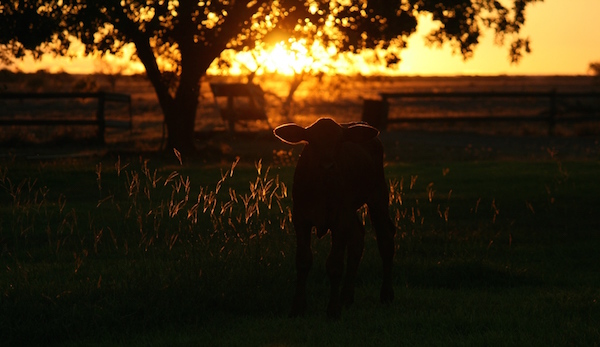Poddies
Host: Eversleigh Station
Written by Jenny Underwood – Owner, Eversleigh Station.
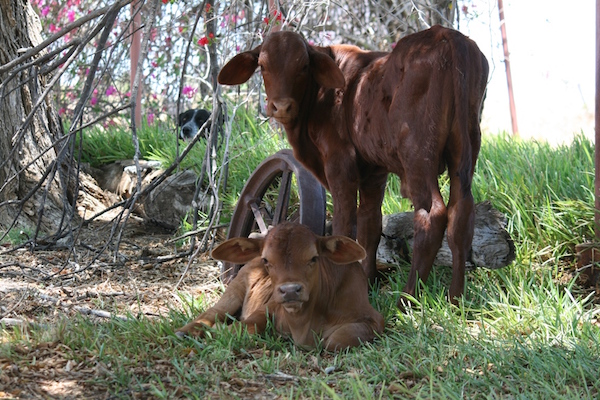 Rainman and Gauge, two poddies that we reared in 2014.
Rainman and Gauge, two poddies that we reared in 2014.
A poddy is a baby animal that is reared by hand. Most cattle and sheep stations rear poddies from time-to-time. While it is always best for a calf or lamb to be reared by its mother there are circumstances which necessitate poddying the baby animal. Sometimes the mother dies leaving the calf orphaned and if it isn’t found quickly it too will most likely die, especially if it is quite young. Sometimes a cow develops “bottle teats” which the calf is unable to suck properly. At other times the calf can become separated from its mother – or mismothered; or, the cow may become too poor to rear the calf on her own and so to save both their lives often the calf is poddied and bottle-fed or raised by a milker cow.
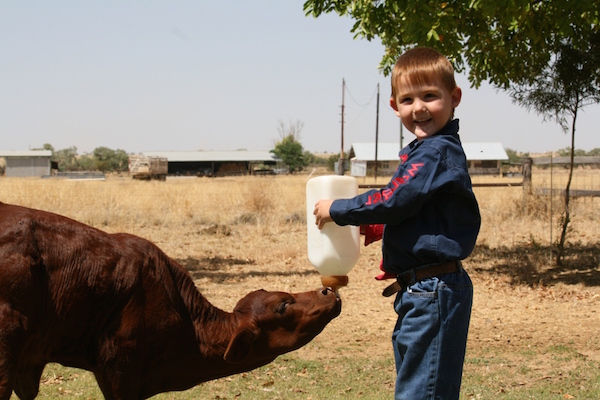 Poddies are generally fed specially-formulated powdered calf milk from a bottle. The calf’s head must be tilted back at such an angle to open a groove from the oesophagus (technically known as the oesophageaoabomasal groove) to the abomasum so it bypasses the rumen. The milk will curdle in the rumen and won’t be absorbed properly.
Poddies are generally fed specially-formulated powdered calf milk from a bottle. The calf’s head must be tilted back at such an angle to open a groove from the oesophagus (technically known as the oesophageaoabomasal groove) to the abomasum so it bypasses the rumen. The milk will curdle in the rumen and won’t be absorbed properly.
We have had a number of poddies over the years, each with its own name and special character. Some can be easy to rear and cause you no heartache whatsoever; others refuse to suck a bottle and alternative methods of keeping them alive have to be found. Some will be powering along and just as suddenly become sick and die for no reason.
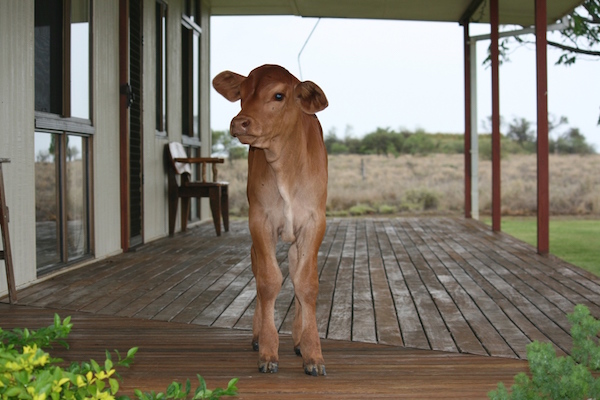 Charlotte the poddy used to jump up on the verandah and look in the window at us when she was hungry or lonely.
Charlotte the poddy used to jump up on the verandah and look in the window at us when she was hungry or lonely.
The important thing for any new born mammal is to get colostrum. Colostrum is present in the mother’s milk for the first few days of lactation. It contains proteins and many of the vital vitamins and minerals needed to fight diseases and guard against viruses and infections. Fortunately colostrum is available commercially and many a baby calf’s life has been saved by giving it colostrum when it is first brought home.
Our current poddy is a heifer calf called Lydia. As far as I know Lydia was one of twin heifers born to a young cow in a paddock near our house. I am certain that Lydia was the older of the twins and she managed to get her initial feed of colostrum after she was born. Why the young mum didn’t take both her calves we will never know but at the tender age of 24 hours old Lydia came home to live with us.
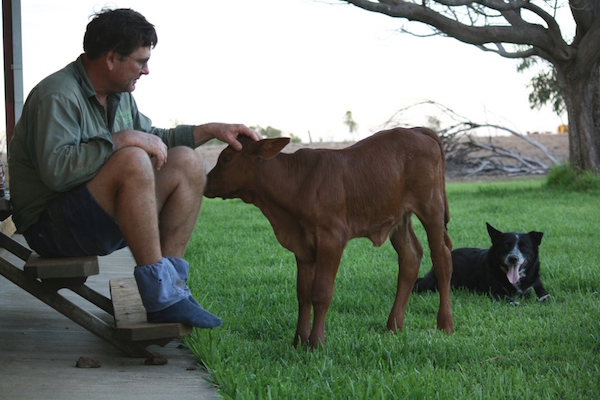 Lydia and my dog, Dixie, joining us for a drink on the steps late one afternoon. She is one month old here.
Lydia and my dog, Dixie, joining us for a drink on the steps late one afternoon. She is one month old here.
Apart from a bad case of colic, which was worrying at the time, Lydia has been a delight and no trouble at all. She loves her bottle and comes running when called; that’s if she isn’t waiting already. She likes nothing better than to come with my dog and me on our daily walks. Most of her days are spent lying around and exploring around the houseyard or outside in the paddock just beyond the fence.
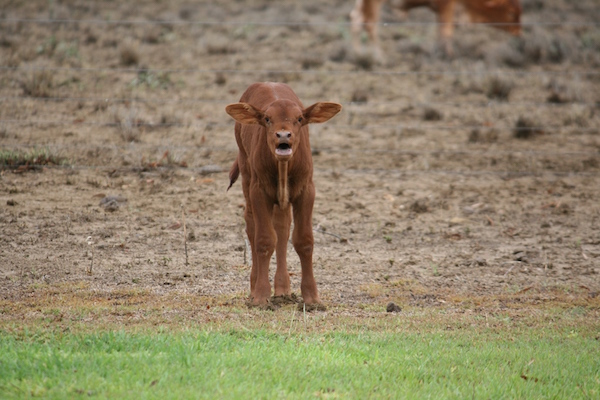 Lydia suggesting that it may be time for a bottle.
Lydia suggesting that it may be time for a bottle.
Lydia has one funny habit and one very annoying habit. The first is a love of vehicles – she spends a lot of her time sitting right beside the door of the work ute or between the four-wheeler bikes or under the truck or whatever machine is handy and has wheels.
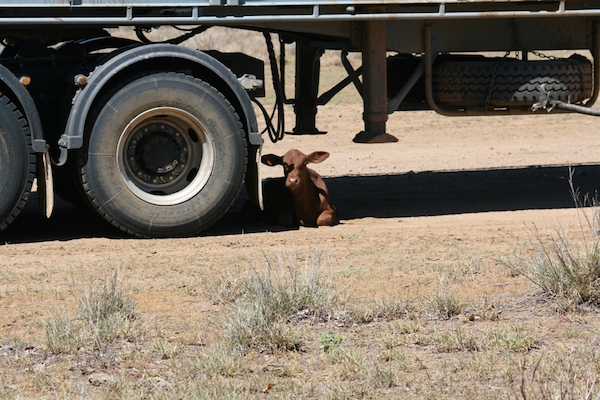 Lydia under the truck.
Lydia under the truck.
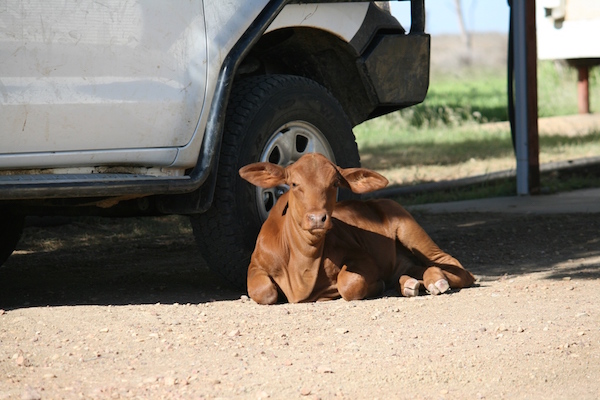 Lydia beside the car.
Lydia beside the car.
Unfortunately her annoying habit is the need to “do her business” on the cement right outside our backdoor. Believe me; it is not easy to housetrain a poddy calf!
Generally we allow three bags of calf milk per poddy before they are weaned from a bottle; this is usually at about the age of 3.5 – 4 months. Before weaning from milk, the calf is generally given calf crumbles and/or pellets to help with the transition. By this age the calf will have started to eat grass or hay (or electrical cords, or the washing, or anything lying around that looks so-o-o interesting and good to chew!)
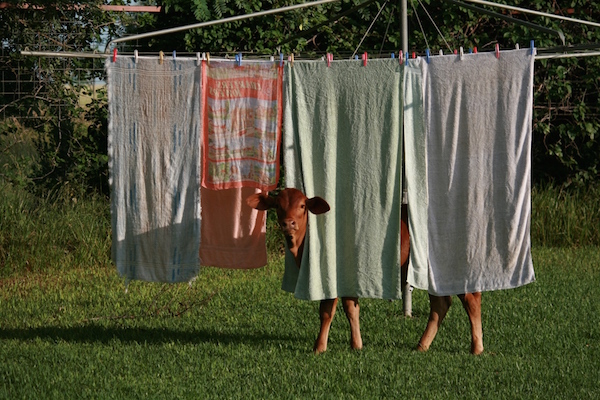 Charlotte had a terrible habit of sucking the washing on the line. Not long after this photo the red teatowel was chewed to ½ its size and beyond further use.
Charlotte had a terrible habit of sucking the washing on the line. Not long after this photo the red teatowel was chewed to ½ its size and beyond further use.
The hardest time for owner and calf is often when the poddy is fully weaned and banished from the house yard and joins other weaners in the paddock. Some poddies are grateful that you have reared them and devoted a large portion of your time to keep them alive and give them the love and attention that they missed from their mother. They will greet you in the paddock and let you give them a scratch and a cuddle. Others are just plain obnoxious and pretend that they have been highly offended by the separation and totally ignore you.
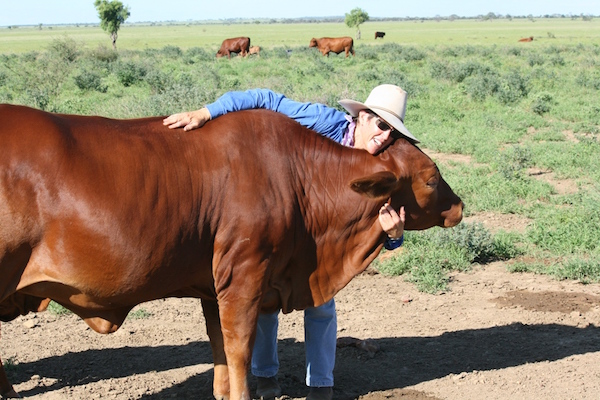 Charlotte coming up for a cuddle; she was about two years old in this photo.
Charlotte coming up for a cuddle; she was about two years old in this photo.
Some poddies become mothers and go on to have and rear their own calves; others which are steers may grow to become bullocks and spend the majority of their lives on the property. No matter what happens to the poddy calf, each has a special place in its owner’s heart and exemplifies the devotion that livestock breeders and their families have for their animals. Children who grow up rearing at least one poddy in their life learn the importance of love and respect for the animal and that each is an individual in its own right.
